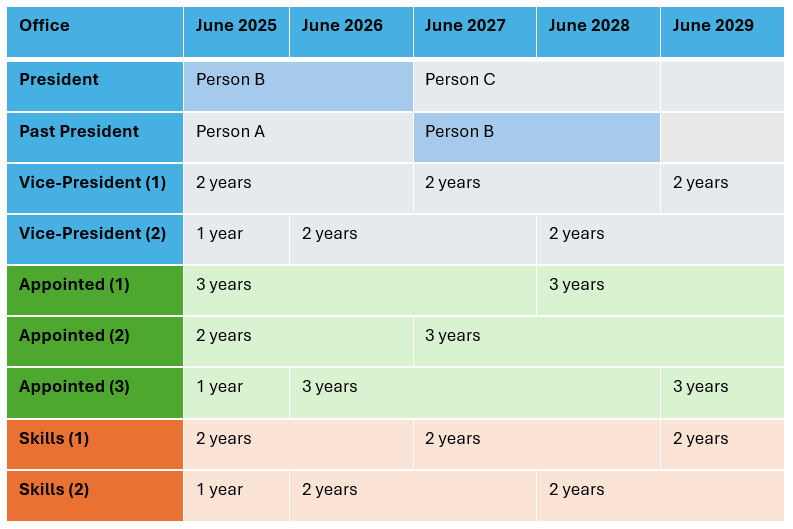New clause 24.1 (d) Three (3) Appointed Directors who at the time of their appointment to the Board are: (i) Serving Councillors; or (ii) Practice Group members;
See also New Clauses 24.7-24.11 regarding appointment process and term of office.
The Board is proposing a constitutional amendment to transition from Council elected Board Directors (Elected Directors) to Directors who are appointed by the Board (Appointed Directors). This change is intended to improve governance stability, ensure continuity of expertise, and address inconsistencies created by varying Council term lengths.
Rationale for the Change
(a) Alignment Between Board and Council Terms
Under the current structure, Board Directors are elected for a three-year term. They must remain Councillors to continue serving on the Board. However, Council terms vary—some are one year, while others may be longer—creating frequent disruptions. Many elected Board Directors lose their eligibility before completing their three-year Board term, requiring them to be co-opted back to maintain continuity. This process is administratively inefficient and inconsistent with best practice governance.
(b) Governance Stability and Continuity
The proposed change ensures that Directors serve their full three-year term without being affected by fluctuations in Council membership. This prevents unplanned turnover and allows for more effective long-term planning, reducing the need for co-opting Directors back onto the Board.
(c) Ensuring Skills-Based Appointments
Moving to a Board-appointed model allows for a structured selection process that prioritises governance expertise, strategic leadership, and organisational needs. Appointed Directors must be Members of the Association and at the time of their nomination, must be Councillors or Practice Group Members. Board appointments will be made based on a transparent selection process. When a vacancy occurs, an Expression of Interest will be made to Ordinary Members. This strengthens decision-making and ensures the Board has the necessary skills mix, rather than being constrained by the availability of elected Councillors.
(d) Clearer Separation of Roles
This change clarifies the distinct roles of the Council and the Board. While the Council remains an important representative body, the Board is responsible for governance, strategic oversight, and fiduciary duties. Appointing Directors independently ensures that Board members are selected based on governance capability rather than Council tenure.
(e) More Effective Succession Planning
A structured appointment process allows for better succession planning, ensuring smooth leadership transitions and reducing the risk of sudden vacancies due to changes in Council membership. This also supports mentorship and knowledge transfer between outgoing and incoming Directors.
(f) Change to terminology and term of office
For clarity, this category of Directors will be referred to as ‘Appointed Directors’ and they will be appointed for three years, with the ability to serve two consecutive terms before taking a break from the Board. The term ‘Skills-based Director’ will be used to refer to those Directors who are not required to be members of the Association but are appointed for specific skills or expertise.



